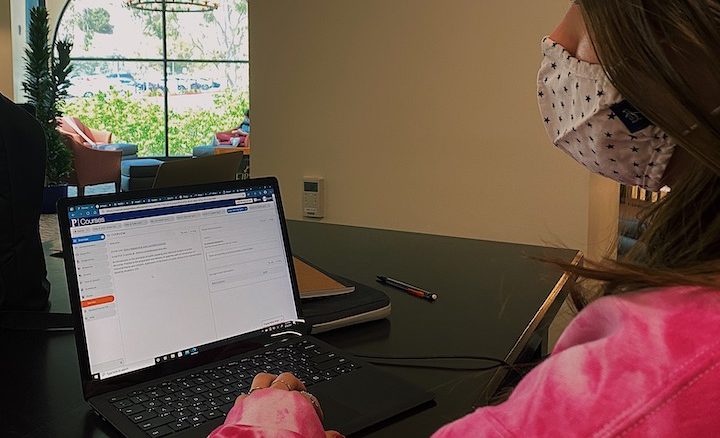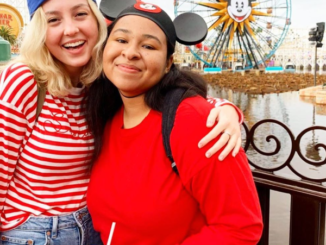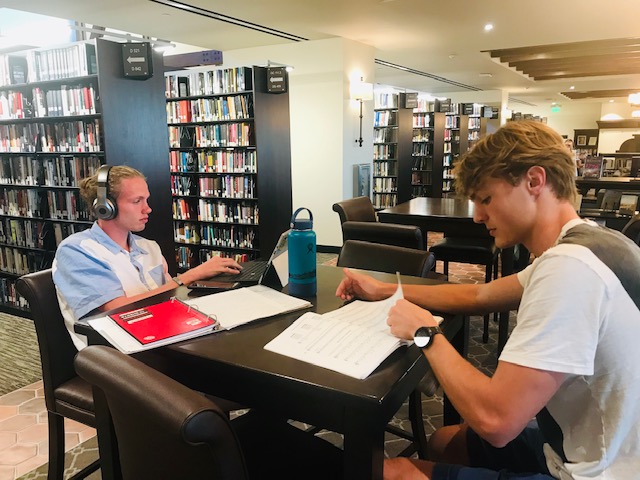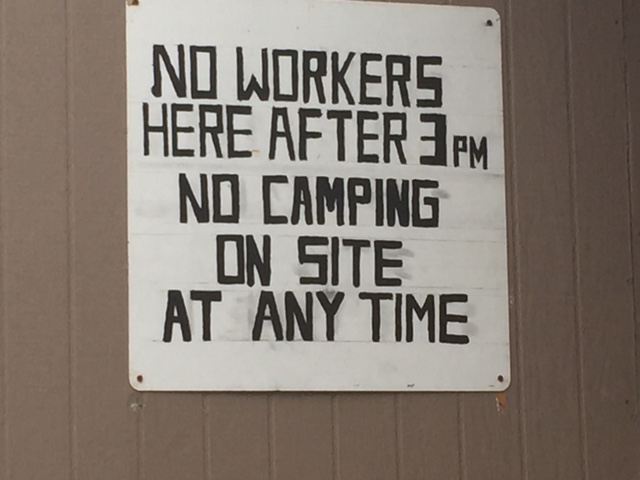
A year of weary eyes behind a tinted screen. A year of Zoom meetings and breakout room introductions.
A year of remote learning, and while the tides are finally changing, there’s some students who have come to appreciate the flexibility of online classes, as others long to return to in-person learning.
Individual professors may choose to retain some online elements when classes return fully to in-person, such as video lectures or hosting virtual study groups on Zoom. Seaver administrators are also forming a working committee this summer to consider whether to offer hybrid in-person and online or fully online classes in the future, particularly for some General Education courses, said Paul Begin, associate dean of Curriculum and General Education at Seaver.
“This summer, we plan to have brainstorming sessions and try to put together a working group,” Begin said.
Hybrid learning at Seaver would solely start on a trial level to assess what works best for the community, Begin said. Some Pepperdine graduate programs, including the Graduate School of Education and Psychology, already offer hybrid and online programs. Undergraduate classes at Seaver have traditionally been in-person and — with the exception of some Elkins general education classes — small. Begin said administrators have to consider the impact of tuition and what courses make sense for hybrid or online learning.
Hybrid learning, what it is and what could stay
Hybrid learning is “a way of combining traditional classroom experiences, experiential learning objectives, and digital course delivery that emphasizes using the best option for each learning objective,” according to the eThink learning website. Hybrid learning can be helpful for students and professors but can “vary widely according to the subject matter taught and the needs of specific groups of learners.”
Seaver has experienced online learning this past year, but hybrid learning involves in-person learning in addition to the online element. Hybrid learning could entail the possibility of some professors still releasing video lectures but having in-class discussion sessions. It can also involve weeks of online learning mixed with long, intensive hours of in-person time sprinkled in.
This is the case with the Graduate School of Education and Psychology. For some students, it is mandatory to attend 12-hour face-to-face sessions on the days allotted, along with attending all online synchronous sessions; other programs offer 60% online class and 40% in-person teaching or require one or two intensive weekends of in-person time, according to the GSEP Academic Catalog.
The past academic year of online learning has advanced how professors use technology and introduced professors to online learning techniques. Zoom classes, prerecorded lectures, learning modules and flexible schedules are all characteristics of remote learning.
From students to professors to administrators, all the people interviewed have mixed opinions about whether or not hybrid learning would be beneficial for Seaver. Hybrid learning brings more flexibility but less camaraderie in the classroom.
“An element I found very helpful during online learning is how all lectures were recorded,” said Niamh Rolston, pre-administration business major first-year. “If for some reason we couldn’t make it to class, we could watch the recorded lesson.”
Even if classes and lectures commenced in-person, Rolston said recording lectures would still be extremely beneficial for students, especially when going back to study before exams.
Thinking strategically about hybrid learning
Administrators are looking at whether to shift any larger, lecture-based general education courses to hybrid or online, Begin said.
“I thought about that a lot,” Begin said. “Maybe we can have some students on campus and make Elkins Hall a great online experience, throw in a bunch of resources and have this robust New York Times master class. It could offset smaller intimate in person classes. I can see that being great.”
Begin said Seaver College is discussing possibilities, including whether to offer partially online classes to students on a need-based basis,whether it’d be for health reasons, familial or financial concerns.
“We would think about using online strategically,” Begin said.
Seaver College has a strong foundation in face-to-face learning and interaction, so Begin does not see Seaver going in this hybrid direction anytime soon. How to assess learning is one challenge, but another is financial. Once Pepperdine is a post-pandemic campus, Begin wonders if tuition would need to be adjusted for a hybrid learning environment in a post-pandemic world.
Course by course, student by student
Everyone interviewed said that what mode of learning works best is a student-by-student decision. What might work for one person may not be the best option for another.
“Options for other versions of classes is beneficial,” said Jordan Holm, Pepperdine’s assistant director of Athletics’ for academics, student development and chaplain. “Definitely the accountability of being in-person is a benefit for all students to some degree.”
Some athletes did find benefits with online learning and could see hybrid working for them in the future.
“Track proved to be more demanding than I expected, so having online classes has helped,” said Alexa Wright, first-year track athlete and psychology major. “I think hybrid learning would give me time to do work later if I have a hard day at practice.”
Pepperdine parent Mandana Aliya Soraya has one first-year and one junior student at Pepperdine and emphasized how different the experiences of being online have been for them.
“My oldest daughter, who is in her third year at Pepperdine, seems to be more focused; this time of being online for her is more frustrating but focus has not been an issue,” Soraya said. “On the contrary, my second daughter, who began Pepperdine online, seems to be less enthusiastic about learning.”
Students find flexibility
Throughout the madness of online learning, Pepperdine students have found that their schedules have become more flexible — a benefit of hybrid learning.
“I have loved online learning,” said Elsa Gillard, junior business administration major. “It has given me a lot of flexibility to focus on other things in my life, and I think it will help me succeed in the future.”
Gillard said hybrid learning allows students to perfect their skills in budgeting their time and learn to work independently from a set schedule.
Josh Nash, first-year music student, said attending online and watching pre-recorded lectures has allowed him more time to delve deeper into his music and learn about managing his time for music and academics. Hybrid learning would enable his collaboration with others and help him connect with his music more.
“It is really good to be in a community where people around you have the same artistic values,” Nash said. “I can hone in on my musical abilities. Hybrid learning lets me do that and more.”
While some students thrived managing their own time, others struggled. It takes discipline — which most students do not have — to learn online, Rasheed Abubakar Rasheed, Amirrudin Kamsin and Nor Aniza Abdullah wrote in Elsevier’s 2020 Computers and Education article.
“Being at home makes me sidetracked much easier than it would be if I was in a classroom,” said Brayden Gratzer, first-year business administration major. “I’m not in my usual learning environment.”
A traditional learning environment would allow for more focus along with less procrastination. Hybrid learning for him would jeopardize the success he could have with purely in-person learning, Gratzer said.
Community built and community burned
Online learning has set up roadblocks in building a typical college community. There are no classroom discussion tables, suitemate study sessions or dinners with professors. Students said they are now confined to often silent breakout rooms and awkward chat boxes in Zoom.
“If we’re not in-person, I think it sacrifices the classes and experiences with going together and doing it altogether,” said Zach Tapp, first-year international business major.
Spiritual life groups, student activities, study groups and other opportunities strengthen the community at Pepperdine. However online learning or hybrid learning can jeopardize that.
Math Professor Elizabeth Thoren described her class as very interactive with loaded student participation that she didn’t think should continue online.
“I see the fractures,” Thoren said. “There is distance with communication.”
The best of both worlds
Journalism Professor Ken Waters taught Com 313, Introduction to Intercultural Communication, a world civilizations GE, to abroad students while he was located in Malibu a few years back.
“It was a mixed bag,” Waters said. “I think the students learned a lot because they were able to evaluate their everyday experiences and observations through the lens of intercultural communication.”
Waters said students would have benefitted from in-person, small-group discussions that most classes provide. However, students could profit from hybrid learning by being able to take some classes from anywhere in the world.
With advancements in technology since Waters taught remotely and the drive students have now coming off of online learning for so long, he believes that hybrid learning could work really well. Waters said there have been no discussions regarding hybrid learning yet.
Emily Chase completed the reporting for this story under the supervision of Dr. Christina Littlefield and Dr. Theresa de los Santos in Jour 241 in Spring 2021. Dr. Littlefield supervised the web story.



